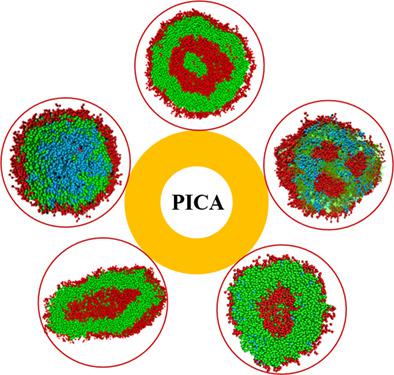当前位置:
X-MOL 学术
›
Polym. Int.
›
论文详情
Our official English website, www.x-mol.net, welcomes your
feedback! (Note: you will need to create a separate account there.)
Kinetics and morphologies in polymerization-induced cooperative assembly: a computer simulation investigation
Polymer International ( IF 2.9 ) Pub Date : 2021-06-20 , DOI: 10.1002/pi.6269 Hui Lu 1 , Wen‐Yuan Song 1 , Ying‐Yi Zou 1 , Wei‐Shao Xu 1 , Yu‐Dou Yan 2 , Hong Liu 1 , Li‐Jun Ma 1
Polymer International ( IF 2.9 ) Pub Date : 2021-06-20 , DOI: 10.1002/pi.6269 Hui Lu 1 , Wen‐Yuan Song 1 , Ying‐Yi Zou 1 , Wei‐Shao Xu 1 , Yu‐Dou Yan 2 , Hong Liu 1 , Li‐Jun Ma 1
Affiliation

|
In the last decade, polymerization-induced self-assembly (PISA) has emerged to be a quite popular technique for preparing a variety of nanoassembly structures in a selective solvent. As a special technique of PISA, polymerization-induced cooperative assembly (PICA) is believed to be able to produce more variable nanostructures and its ways of regulation seem more flexible. The process of PICA is studied systematically with a simulation method for discovering possible ways of regulation of morphologies. We find that the existence of solvophobic homopolymers yields a ‘chain growth retarding effect’, which effectively slows down the reaction kinetics of the polymerization. Besides proving the transition from lower-order morphologies to higher-order morphologies as reported in experiments, we also find a novel transition from higher-order morphologies to lower-order morphologies, as a result of the self-adaptation behavior of the system. For the first time, we demonstrate that this behavior is able to be well described as a kind of inverse flip-flop process of vesicle structures to thermodynamically stable micelle structures. We also find that the obvious contrast of length between the solvophilic macro-chain transfer agents and solvophobic blocks is beneficial to the emergence of plentiful kinds of structures. The results of this study are helpful for understanding the crucial factors for precisely regulating the morphologies in PICA, as well as guiding the way to improve experimental technologies. © 2021 Society of Industrial Chemistry.
中文翻译:

聚合诱导协同组装中的动力学和形态学:计算机模拟研究
在过去十年中,聚合诱导自组装 (PISA) 已成为一种在选择性溶剂中制备各种纳米组装结构的非常流行的技术。作为PISA的一项特殊技术,聚合诱导协同组装(PICA)被认为能够产生更多可变的纳米结构,其调控方式似乎更加灵活。采用模拟方法系统地研究了 PICA 的过程,以发现可能的形态调控方式。我们发现疏溶剂均聚物的存在会产生“链增长阻滞效应”,从而有效减缓聚合反应动力学。除了证明实验中报告的从低阶形态到高阶形态的转变之外,由于系统的自适应行为,我们还发现了从高阶形态到低阶形态的新转变。我们首次证明,这种行为可以很好地描述为一种囊泡结构到热力学稳定胶束结构的逆触发器过程。我们还发现,亲溶剂大链转移剂和疏溶剂嵌段之间明显的长度对比有利于多种结构的出现。本研究结果有助于了解精确调控PICA形态的关键因素,以及指导改进实验技术的途径。© 2021 工业化学学会。我们首次证明,这种行为可以很好地描述为一种囊泡结构到热力学稳定胶束结构的逆触发器过程。我们还发现,亲溶剂大链转移剂和疏溶剂嵌段之间明显的长度对比有利于多种结构的出现。本研究结果有助于了解精确调控PICA形态的关键因素,以及指导改进实验技术的途径。© 2021 工业化学学会。我们首次证明,这种行为可以很好地描述为一种囊泡结构到热力学稳定胶束结构的逆触发器过程。我们还发现,亲溶剂大链转移剂和疏溶剂嵌段之间明显的长度对比有利于多种结构的出现。本研究结果有助于了解精确调控PICA形态的关键因素,以及指导改进实验技术的途径。© 2021 工业化学学会。我们还发现,亲溶剂大链转移剂和疏溶剂嵌段之间明显的长度对比有利于多种结构的出现。本研究结果有助于了解精确调控PICA形态的关键因素,以及指导改进实验技术的途径。© 2021 工业化学学会。我们还发现,亲溶剂大链转移剂和疏溶剂嵌段之间明显的长度对比有利于多种结构的出现。本研究结果有助于了解精确调控PICA形态的关键因素,以及指导改进实验技术的途径。© 2021 工业化学学会。
更新日期:2021-06-20
中文翻译:

聚合诱导协同组装中的动力学和形态学:计算机模拟研究
在过去十年中,聚合诱导自组装 (PISA) 已成为一种在选择性溶剂中制备各种纳米组装结构的非常流行的技术。作为PISA的一项特殊技术,聚合诱导协同组装(PICA)被认为能够产生更多可变的纳米结构,其调控方式似乎更加灵活。采用模拟方法系统地研究了 PICA 的过程,以发现可能的形态调控方式。我们发现疏溶剂均聚物的存在会产生“链增长阻滞效应”,从而有效减缓聚合反应动力学。除了证明实验中报告的从低阶形态到高阶形态的转变之外,由于系统的自适应行为,我们还发现了从高阶形态到低阶形态的新转变。我们首次证明,这种行为可以很好地描述为一种囊泡结构到热力学稳定胶束结构的逆触发器过程。我们还发现,亲溶剂大链转移剂和疏溶剂嵌段之间明显的长度对比有利于多种结构的出现。本研究结果有助于了解精确调控PICA形态的关键因素,以及指导改进实验技术的途径。© 2021 工业化学学会。我们首次证明,这种行为可以很好地描述为一种囊泡结构到热力学稳定胶束结构的逆触发器过程。我们还发现,亲溶剂大链转移剂和疏溶剂嵌段之间明显的长度对比有利于多种结构的出现。本研究结果有助于了解精确调控PICA形态的关键因素,以及指导改进实验技术的途径。© 2021 工业化学学会。我们首次证明,这种行为可以很好地描述为一种囊泡结构到热力学稳定胶束结构的逆触发器过程。我们还发现,亲溶剂大链转移剂和疏溶剂嵌段之间明显的长度对比有利于多种结构的出现。本研究结果有助于了解精确调控PICA形态的关键因素,以及指导改进实验技术的途径。© 2021 工业化学学会。我们还发现,亲溶剂大链转移剂和疏溶剂嵌段之间明显的长度对比有利于多种结构的出现。本研究结果有助于了解精确调控PICA形态的关键因素,以及指导改进实验技术的途径。© 2021 工业化学学会。我们还发现,亲溶剂大链转移剂和疏溶剂嵌段之间明显的长度对比有利于多种结构的出现。本研究结果有助于了解精确调控PICA形态的关键因素,以及指导改进实验技术的途径。© 2021 工业化学学会。










































 京公网安备 11010802027423号
京公网安备 11010802027423号